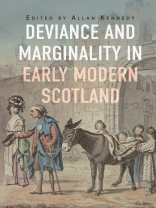An exploration of the complex and multifaceted connection between deviant behaviour and social marginality in Scotland between the sixteenth and eighteenth centuries.
During the early modern period in Scotland, deviant behaviour often went hand-in-hand with social marginality. Individuals might be ejected from the mainstream after breaching core behavioural standards; the experience of marginality itself often necessitated transgressive behaviour as a survival strategy; and, for some minority groups, the simple maintenance of their accustomed culture or lifestyle was understood through the lens of deviance. To be marginalised and to be deviant were, in many cases, two sides of the same coin.
Focusing on a range of behaviours, including irregular sex, violent and verbal assault, petty criminality, piracy, political dissidence, and religious nonconformity, this book explores the connection between deviance and marginality in early modern Scotland, particularly in the sixteenth and seventeenth centuries. It assesses why certain behaviours were judged to deserve social marginalisation, what mechanisms were used to enforce this, how individual and groups responded to it, and what opportunities existed for avoiding, escaping, or mitigating its effects. The result is a fresh and innovative perspective on early modern Scotland, one that not only recovers the experiences of people long excluded from historical discussion, but also offers insights into the nature of crime and deviance in the pre-modern world. Specific topics covered include sexual deviance, defining words as witchcraft, piracy and the state, the weaponisation of ‘marginality’ in verbal violence, covenanting women, and the connection between deviance and the ‘common musician’.
Mục lục
List of Contributors
Acknowledgements
List of Abbreviations
Introduction: The Deviant Margins
Allan Kennedy
Part I: Conceptualising Deviance
1 Conceptualising Deviant Sex in Seventeenth-Century Scotland
Allan Kennedy
2 Assault in the Margins: Gendered Violence in Seventeenth-Century Bute
Ashlyn Cudney
3 Disorderly, Deviant, Dangerous: Defining Words as Witchcraft in Early Modern Scottish Communities
Sierra Dye
4 ‘Believing na evill nor injury’: Space, Place, and Crime in Sixteenth-Century Scottish Burghs
J. R. D. Falconer
Part II: Performing Deviance
5 Piracy, the State, and the Burghs of South-West Scotland, 1560-1603
Scott Carballo
6 ‘Ane legall man quhairof we are glad’: Male Violence, Female Agency, and the Quest for Legitimacy in the Story of Seumas an Tuim
Graham Watson
7 Covenanting Women in Scotland: Nonconformity, Marginality, and Community, c.1660-1690
Scott Eaton
8 Life at the Margins of Law and Order: James Macpherson – The Scottish Robin Hood
Anne-Marie Kilday
Part III: Testing the Boundaries
9 The Common Musician and Deviance in Early Modern Scotland
Aaron Mc Gregor
10 Marginally Speaking: Insults and Concepts of Marginality in Sixteenth-Century Scottish Towns
Elizabeth Ewan
11 Ejected Academics: Marginalised Scottish University Professors between the Reformation and Revolution
Salvatore Cipriano
12 Partial Conformity in Restoration Scotland, 1662-1669
Jamie Mc Dougall
Afterword
Index
Giới thiệu về tác giả
SALVATORE CIPRIANO is Associate Director of Career Coaching and Education, Stanford University. He holds a Ph.D. in Early Modern European History from Fordham University.












